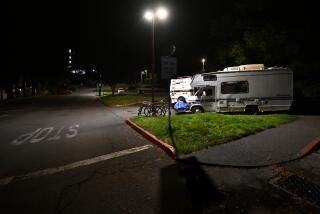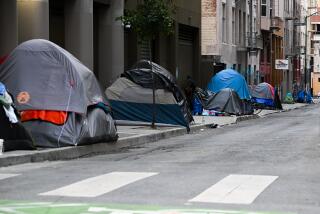A gentrifying block is not quite ready for its close-up
It was a last-minute trip on a budget too tight to accommodate holiday airfare.
A ticket on the MegaBus cost a fraction of what I’d have paid to fly. The bus is not the bullet train, not by a long shot. The overnight trip is seven hours, and that’s on a good night.
But the double-decker buses have Wi-Fi, power outlets, reclining seats and seat belts. There’s no fee to check a suitcase. And I didn’t have to wonder how much liquid I could take onboard or whether my nail clippers would be confiscated.
Most of the passengers waiting to board with me at Union Station were young and traveling light. I wore the public version of pajamas — T-shirt and sweat pants — and carried a duffel bag stuffed with blanket, pillow, sweatshirt, foam earplugs and satin eye mask.
My preparation paid off. As we climbed the Grapevine, I stretched out across an empty seat, stuck in my earplugs, covered my eyes and went to sleep. I didn’t wake up until the bus rolled into the CalTrain station in San Francisco.
It wasn’t quite dawn and the short cab ride to my daughter’s apartment revealed a Market Street I’d never seen — quiet, virtually empty and unexpectedly serene.
By the next day, a sleepless night had convinced me that must have been a dream.
::
My daughter lives in a studio apartment on a seedy stretch of Market that’s in the midst of a makeover. Hers is an ancient building where neighbors are so tightly packed, I can tell you what the couple in the next apartment argued about last weekend.
The tenants have learned, over time, to tune each other out. But it’s harder to tune out the late-night rants that recently began wafting up from the sidewalk.
The vulgar tirades go on for hours. The culprit is a man who lives in the flophouse down the block. My daughter and her neighbors have called the police. Occasionally they come and the screaming quiets, until the next night.
Even in daylight the man looks scarier than our typical derelicts, who congregate around the corner, but don’t block the sidewalk, panhandle or try to stare you down.
We knew going in that this neighborhood was a gamble. Cops warned me two years ago, as we were apartment hunting, that the building was flanked by “parolee motels” crammed with lowlifes, addicts and people wrestling with mental illness.
But there was an upscale restaurant across from her building and a popular tavern next door. The sidewalks were filthy, but the boulevard was busy and brightly lit, and no one bothered her.
The odds seemed to shift in our favor last year, when Twitter moved into a vacant building a few blocks away, and the neighborhood began to ready itself for an onslaught of young techies with steady paychecks.
Soon construction crews were busy all along Market. On every visit I noticed another banner announcing luxury housing prospects. And every block seemed to have a new bakery or artisan coffee shop.
My daughter figured she had it made when Whole Foods broke ground nearby.
She didn’t anticipate the growing pains that gentrification would bring — businesses pushed out by rising rents, troublemakers herded off the sidewalks and into fleabag hotels.
The Buck Tavern next door closed when its lease expired last fall, priced out of the market by the rising aspirations of landlords. Her other next-door neighbor, Restrospect Custom Furniture, shut down last weekend, after more than 20 years in its Market Street spot.
Now her block includes two empty storefronts, a liquor store and a so-called parolee motel.
And the men hanging out on the sidewalk seem bigger, louder, rougher, less respectful of rules — buoyed by the loss of stabilizing forces that is gentrification’s cost.
::
You have to love a place that debates whether it should be legal to walk around naked in public, but makes it a crime to feed pigeons on a public sidewalk.
San Francisco is a city that tolerates incongruity, celebrates it even. It’s tight, compact and crowded. People learn to coexist because they’re forced to brush up against one another in ways we don’t have to in Southern California.
The city has become familiar with the dance that gentrification requires. Done wrong it’s a land grab by the moneyed that squeezes out the poor and drains a community’s culture. Done well it’s a way to harness affluence and energy to revitalize a neighborhood’s core.
It’s too soon to say what’s going to happen in my daughter’s Mid-Market corridor. Not long ago, half its office space was empty and almost one-third of its storefronts shuttered. It’s been a mecca for down-and-outers, with easy access to transportation and the city’s highest concentration of single-room-occupancy hotels.
Now neighborhood groups are finding their voice, pushing community-building projects. On the drawing board are an arts district, a skate park, a community garden.
I see the changes in little ways. The Empire Liquor and Grocery Store used to have a colorful handwritten sign taped to the front door. “No crackheads! No methies!” it read. Now it’s been replaced by a poster pushing lottery tickets.
But progress can be hard to spot when you’re trapped in the tumult that turnaround requires.
“My partner and I are ashamed to have people come over to our place,” wrote a woman on the Facebook page of a community group. “I appreciate the efforts to revamp this neighborhood.” But she’s tired of “used needles and human waste littering the sidewalks.”
My daughter feels the conflict too, from the comfort of her room. That irascible man whose shouting interrupts her sleep represents the tension of accommodation and the ragged pace of change.
More to Read
Start your day right
Sign up for Essential California for news, features and recommendations from the L.A. Times and beyond in your inbox six days a week.
You may occasionally receive promotional content from the Los Angeles Times.







